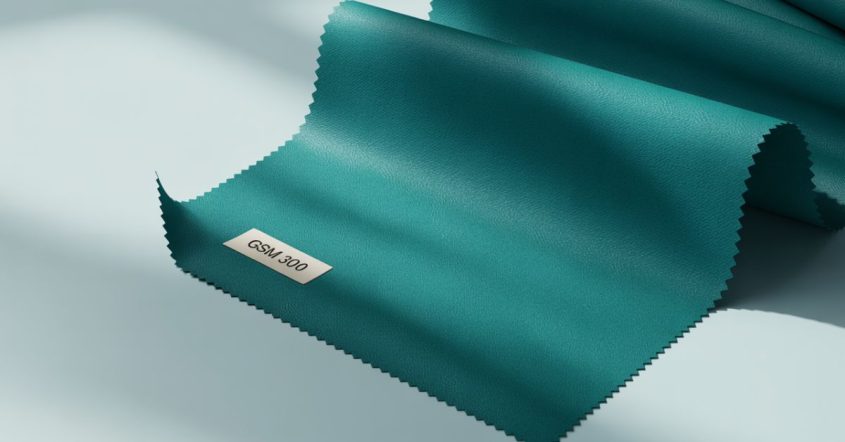When buying or choosing fabric, one common term you may come across is “GSM.” Whether you’re making clothes, home textiles, or working on a creative project, knowing about GSM is essential. GSM stands for Grams per Square Meter, and it’s a way to measure the weight and thickness of fabric. This measurement helps you understand how light, medium, or heavy a fabric is.
In this article, we’ll explain what GSM means, why it matters, and how it helps you choose the right fabric. We’ll also look at the different types of fabrics based on GSM and their uses.
What is GSM in Fabric?
GSM stands for Grams per Square Meter. It tells you how much one square meter of fabric weighs. For example, if a fabric has 150 GSM, it means one square meter of that fabric weighs 150 grams.
GSM is important because it gives you an idea of the fabric’s thickness, heaviness, and feel. A fabric with a low GSM is light and thin. A fabric with a high GSM is thick and heavy.
How is GSM Calculated?
GSM is calculated using the following steps:
- Take a sample piece of fabric.
- Cut it into a square shape (usually 10cm x 10cm).
- Weigh the square using a digital scale.
- Multiply the weight by 100 to get the GSM.
Formula:
GSM = (Fabric weight in grams / Area in square meters)
Special tools like a GSM cutter are also used in the textile industry to get accurate results.
GSM Categories and Their Characteristics
GSM values help categorize fabrics into three main types: lightweight, medium-weight, and heavyweight.
1. Lightweight Fabrics (30–150 GSM)
These fabrics are thin, breathable, and soft. They are ideal for hot weather and clothing that needs to flow.
Examples:
- Chiffon
- Organza
- Cotton Voile
- Taffeta
- Poplin
Characteristics:
- Easy to wear
- Suitable for layering
- Often used in summer clothes and linings
2. Medium-weight Fabrics (150–350 GSM)
These are versatile fabrics used for many types of clothing and home items.
Examples:
- Velvet
- Sateen
- Fleece
- Velboa
- Suede
Characteristics:
- Balanced structure
- Good for both warm and cool seasons
- Used in shirts, trousers, and light jackets
3. Heavyweight Fabrics (350+ GSM)
These fabrics are thick, strong, and durable. They are perfect for colder climates or heavy-duty use.
Examples:
- Denim
- Wool
- Canvas
- Leatherette
Characteristics:
- Warm and protective
- Less breathable
- Used in jackets, jeans, and upholstery
Importance of GSM in Fabric Selection
GSM helps you understand the behavior of fabric before using it. Here are some key reasons why GSM is important:
- Thickness: Higher GSM means thicker fabric, which is important for winter clothes.
- Durability: Heavy GSM fabrics last longer and can handle more wear and tear.
- Drape: Low GSM fabrics flow well and are ideal for dresses and curtains.
- Comfort: Lightweight fabrics feel softer and are better for hot weather.
- Cost: Heavier fabrics usually cost more because they use more material.
Applications of Different GSM Fabrics
Each GSM category is suitable for different purposes. Let’s see where they are commonly used.
Apparel
- Lightweight (30–150 GSM):
- Summer dresses
- Blouses
- Scarves
- Lingerie
- Summer dresses
- Medium-weight (150–350 GSM):
- Trousers
- Skirts
- Blazers
- Casual jackets
- Trousers
- Heavyweight (350+ GSM):
- Coats
- Jeans
- Winter jackets
- Workwear
- Coats
Home Textiles
- Bed linens: Usually 150–300 GSM for comfort and durability.
- Curtains: Heavier GSM for blackout or decorative use.
- Towels: Usually 400–600 GSM for softness and absorbency.
- Tablecloths and napkins: Medium to heavy GSM for structure and strength.
Industrial Uses
- Tents and canopies: Often use 500+ GSM for weather protection.
- Backpacks and luggage: 600+ GSM for strength.
- Upholstery: Heavyweight fabrics for durability and long-lasting use.
Factors Affecting Fabric GSM
Several factors can affect the GSM of fabric, even if it looks the same at first glance.
1. Fiber Type
- Natural fibers like cotton, wool, and linen usually weigh differently than synthetic fibers like polyester and nylon.
- Blended fabrics can also have varied GSM depending on their mix.
2. Weave Structure
- A tightly woven fabric has a higher GSM than a loosely woven one.
- For example, twill and satin weaves generally feel thicker than plain weaves.
3. Fabric Finish
- Brushed fabrics like fleece have more weight due to the extra texture.
- Coated or waterproof fabrics also have a higher GSM.
How to Measure GSM
To measure GSM accurately, you can follow these steps:
Tools Needed:
- GSM Cutter (optional)
- Digital weighing scale
- Ruler or measuring tape
Steps:
- Cut a 10cm x 10cm square of fabric.
- Weigh it on a digital scale.
- Multiply the weight by 100 to get GSM.
Example:
If the 10cm x 10cm fabric sample weighs 2.5 grams:
GSM = 2.5g × 100 = 250 GSM
If you don’t have a GSM cutter, use scissors and a ruler for measurement. Make sure the sample is neat and lies flat on the scale.
GSM vs. Fabric Quality
People often think that higher GSM means better quality. That’s not always true. GSM only tells you how heavy or thick a fabric is—not how strong, soft, or well-made it is.
Consider These Points:
- A lightweight silk with low GSM can be more luxurious than a heavy polyester fabric.
- Quality also depends on fiber type, yarn count, weave, and finishing.
- Use GSM along with other fabric properties when making a choice.
Conclusion
GSM is a useful guide when choosing fabrics. It helps you understand the weight, feel, and purpose of the fabric before you use it. Whether you’re making a summer dress, a cozy winter coat, or new curtains for your home, knowing the GSM will help you pick the right material.
By combining GSM knowledge with an understanding of fabric type, weave, and finish, you’ll make better, more informed decisions for any textile project. So the next time you shop for fabric, check the GSM—and choose with confidence.
















